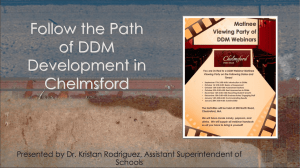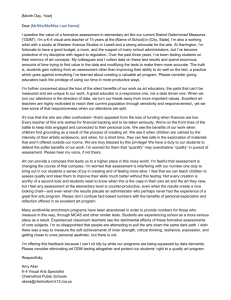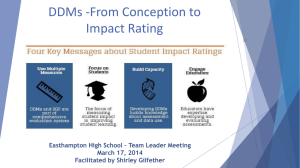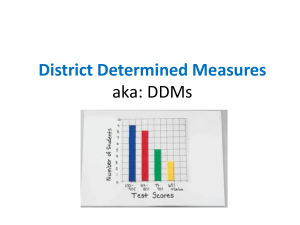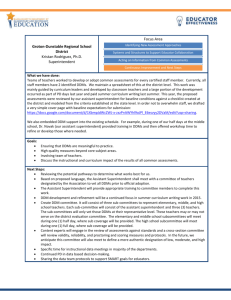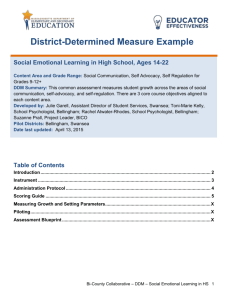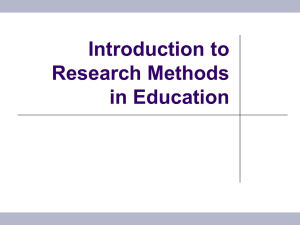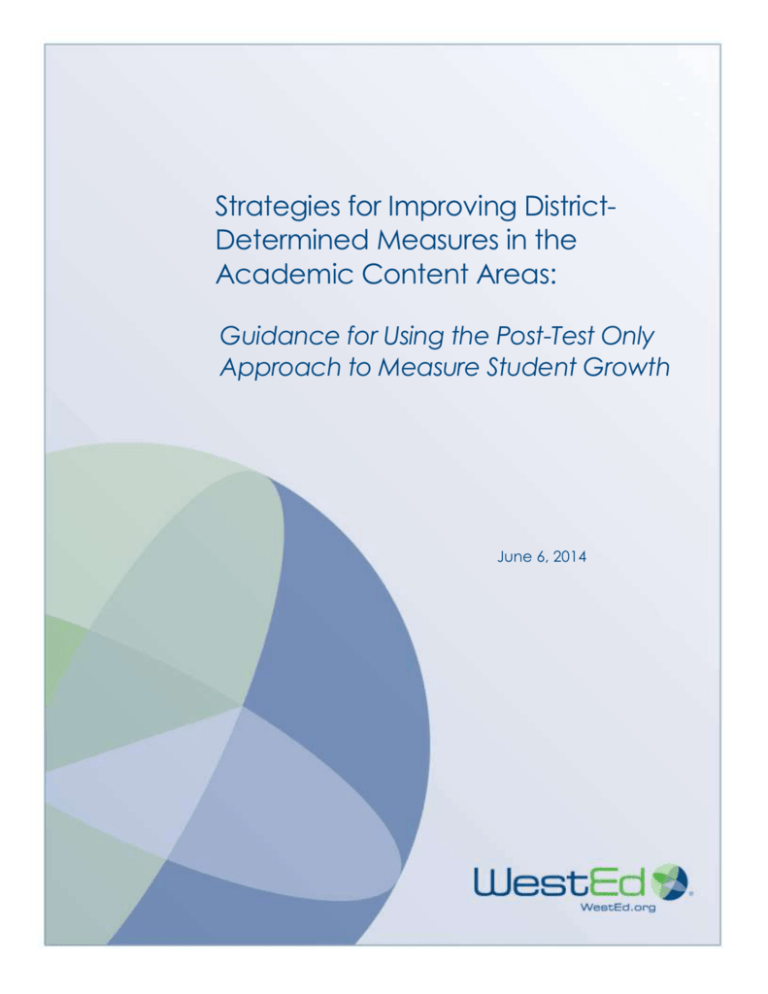
Strategies for Improving DistrictDetermined Measures in the
Academic Content Areas:
Guidance for Using the Post-Test Only
Approach to Measure Student Growth
June 6, 2014
WestEd — a national nonpartisan, nonprofit research, development,
and service agency — works with education and other communities
to promote excellence, achieve equity, and improve learning for
children, youth, and adults. WestEd has 17 offices nationwide, from
Washington and Boston to Arizona and California, with its
headquarters in San Francisco. For more information about WestEd,
visit WestEd.org; call 415.565.3000 or, toll-free, (877) 4-WestEd; or write:
WestEd / 730 Harrison Street / San Francisco, CA 94107-1242.
© 2014 WestEd. All rights reserved.
Table of Contents
Introduction: Purpose of This Guidance Document
i
Section I. Using the Post-Test Only Approach to Measure Student
Growth with an Emerging DDM
1
Section II. Example Assessment #1, Using the Post-Test Only Approach
to Measure Student Growth
3
Section III. Suggestions for Refining Example Assessment #1 to Ensure
Usefulness as a DDM
10
Section IV. Example Assessment #2, Using the Post-Test Only Approach
to Measure Student Growth
13
Section V. Suggestions for Refining Example Assessment #2 to Ensure
Usefulness as a DDM
17
Appendix A: Key ESE-Developed Resources to Support Districts with
Implementing DDMs that Effectively Measure Student Growth
19
Appendix B: Recommended External Resources on Measuring
Student Growth: Guidance from the Research and Measurement
Communities
22
Introduction: Purpose of This Guidance Document
Educators and administrators engaging in the selection and/or development of districtdetermined measures (DDMs) have been challenged with answering a key question about their
emerging DDMs: Does this measure detect some type of change in performance that can be
attributed to student growth? In a key resource developed to support districts with this
challenge, 1 the Massachusetts Department of Elementary and Secondary Education (ESE)
explains why it is so important that a DDM measure growth:
Students come to school each year with a wide range of prior academic achievement and therefore begin
their next year of instruction with varying levels of readiness to access the curriculum, a situation that is
beyond the control of the educator assigned to teach them. Measuring educators’ effectiveness solely by
the achievement level of their students cannot account for these prior conditions. By comparison,
measuring growth can help level the playing field. Improvement in student performance is a more
meaningful and fair basis for determining the trends and patterns that will yield the educator’s rating of
impact on student learning, growth, and achievement. (p. 8)
One strategy for supporting DDM developers in Commonwealth districts with this challenge is
to provide concrete examples of open-source, locally developed assessments that are useful for
the purpose of measuring student growth. The aim of sharing a sample of promising DDMs is to
stimulate further discussion about how, with a few strategic changes, existing assessments may
be adapted for use as DDMs. According to ESE, the strongest DDMs will emerge from districts
that have engaged in systematic study of the appropriateness and usefulness of their
assessments specifically for determining what students have learned from their educators
during a course of instruction.
A number of approaches to measuring growth that are described in a key ESE-developed
resource, Technical Guide B, do not require complex psychometric methods or statistical
computations. 2 Each of these approaches has unique strengths and limitations. Many measures
can be adapted to a variety of approaches to measuring growth, so decision-makers will want
to use their professional judgment in weighing the pros and cons of each, considering
competing goals and determining the approaches best suited for their contexts.
This document is intended to support those educators and administrators who are considering
a post-test only approach to measuring growth with their locally developed assessments.
1
Massachusetts Model System for Educator Evaluation, Part VII: Rating Educator Impact on Student Learning Using
District-Determined Measures of Student Learning, Growth, and Achievement.
2
Companion documents have been developed that highlight three other common approaches to measuring
growth: (a) a pre-test/post-test approach; (b) a holistic evaluation approach; and (c) a repeated measures
approach.
WestEd_MA DDM Guidance for Academic Content Areas_Post-Test Only Approach
i
It includes the following:
key resources developed by ESE that offer guidance for monitoring the technical quality
of DDMs and for selecting a reasonable approach to measuring growth;
a summary of the strengths and limitations of the post-test only approach to examining
student growth;
sample assessments submitted by Commonwealth districts, with suggestions for how
the developers might refine each measure for use as a DDM; and
information about a number of external resources that educators and administrators
may find helpful if they elect to pursue a post-test only approach.
It is hoped that this guidance document will help district personnel transform strong locally
developed measures of achievement and/or performance into promising DDMs that are
particularly effective in evaluating student growth.
WestEd_MA DDM Guidance for Academic Content Areas_Post-Test Only Approach
ii
Section I. Using the Post-Test Only Approach to Measure
Student Growth with an Emerging DDM
The post-test only approach involves a
single administration of an assessment of
what students know and can do following
instruction. To measure growth with this
approach, developers must collect
additional information about students’
baseline knowledge and skills, i.e., what
they know and can do prior to instruction.
Post-test only measures typically include
traditional direct measures such as
summative exams (unit exam, mid-term
or final exam, end-of-year test, or end-ofcourse exam) or nontraditional measures
such as capstone projects. This approach
also may use indirect measures (e.g.,
number of students electing more
advanced courses in relevant content
areas in subsequent years).
Key ESE-Developed Resources to Support Districts
with Implementing DDMs that Effectively Measure
Student Growth
Technical Guide A (see especially pp. 25–29, 32, 34)
Technical Guide B (see especially pp. 6–7 and 11–20
and Appendix B)
Assessment Quality Checklist and Tracking Tool
Using Current Assessments in District-Determined
Measures: Leveraging the Curriculum-Embedded
Performance Assessments from the Model
Curriculum Units (see especially pp. 2–3, 6–8,
and 11)
Webinar Series #2 (slides 21–41 and 44–53), #5
(slides 20–27 and 32), #6 (slides 10–16), #7 (slides
11–12, 25–32, and 34), and #9 (slides 25–29)
Implementation Brief: Scoring and Setting
Parameters
This approach has a number of strengths and limitations, based on guidance from experts in the
educational research and measurement communities. These are summarized in Table 1.3
3
See Appendix B for research- and measurement-based resources for the post-test only approach
WestEd_MA DDM Guidance for Academic Content Areas_Post-Test Only Approach
1
Table 1. Strengths and Limitations of the Post-Test Only Approach to Measure Student Growth
Strengths
Often the best approach when a measure of
achievement or performance can only be
administered once (e.g., building a house).
Useful when an existing measure is strongly linked
to instruction (e.g., curriculum-embedded
assessment) or is a well-established external tool
(e.g., certification exam or Advanced Placement
test).
Limitations
Developers will need to consider how to capture
baseline information within the same year or course
and produce scores that could be compared to the
post-test.
Districts need to think carefully about how they are
measuring students’ ability relative to where they
started.
Single-year scores are not precise indicators of
educator performance because results are
confounded by cohort effect (i.e., different classes
of students may be systematically different for
reasons not related to instruction).
Districts interested in using the post-test only approach also may want to attend to the
following considerations:
Wherever possible, districts are also encouraged to use other approaches to measuring
growth.
One approach to using a post-test only model would be to identify key knowledge or
skills that are taught during the year or course and develop a test/task or scoring
method that allows educators to measure growth. To promote confidence in findings,
the baseline test/task should be strongly aligned to and similar to the post-test. In most
cases, however, it should not be exactly the same as the post-test. The post-test only
approach differs from the pre-test/post-test approach in this important way.
It is critical to include comparative baseline information that helps predict the expected
level of achievement, such as the difference from the previous unit’s test or previous
year’s graduation rate.
A measure must be of exceptionally high quality in terms of content alignment and
usefulness to justify this approach.
DDM teams also will want to consider item quality, test length, accessibility for all
students, and when and how the measure is administered and scored.
WestEd_MA DDM Guidance for Academic Content Areas_Post-Test Only Approach
2
Section II. Example Assessment #1, Using the Post-Test Only
Approach to Measure Student Growth
The following assessment was submitted by the Mathematics Department Chair at Scituate
Public Schools and was developed by a team of educators who adapted an existing measure for
use as a DDM. For more information about the midterm exam or to obtain the final exam,
please contact Dr. John Ekstrom at jekstrom@scit.org.
Locally Developed Assessment Well-Suited for Use as a DDM
Submitted by: Dr. John Ekstrom, Mathematics Department Chair (K-12), Scituate Public Schools
Course/Grade: High School Mathematics
Assessment Name: Pre-Calculus Mid-Term Examination
Item Types: Constructed- and Selected-Response
Description: This midterm examination was developed by Scituate High School and Scituate Junior High School
math department members. Test questions are aligned to the Massachusetts Mathematics Curriculum
Framework in high school mathematics.
The midterm exam includes 14 constructed-response items. Some challenge students to find solutions in reallife contexts, such as hitting a baseball or driving to a popular destination, while others ask students to solve
problems using sets of complex numbers. All items have multiple parts, requiring students to plot trajectories,
apply quadratic models, and sketch graphs of functions in addition to solving problems.
The remaining 20 questions are selected-response items. These items are accompanied by five response
options; “None of these” is an option in half of the items. All items require students to apply knowledge and
skills that they were expected to learn in the first semester of instruction. For example, students are asked to
estimate a slope, describe a scatter plot, identify intercepts, and demonstrate understanding of functions.
Following the pilot administration, educators found that the scores from the midterm exam correlated well
with other measures of achievement, such as midterm grades.
WestEd_MA DDM Guidance for Academic Content Areas_Post-Test Only Approach
3
Pre-Calculus Midterm Answer Sheet 2014
Name: _______________________________
Part I: Open-Response
1. David Ortiz hit one of Mr. Parkins’ fast balls (impossible, but pretend) when it was 2 feet off the
ground above home plate. At a distance of 100 feet from home plate the ball was 152 feet high,
and at a distance of 150 feet from home plate it was 82 feet high. Let x = the distance from
home plate and let y = the height of the ball at distance x.
a. What is the height of the ball when David Ortiz
makes contact? (This should be EASY)
b. Give a rough sketch of the path that the ball
will travel while in the air, labeling the diagram
with the points given above. Be sure to draw
an xy-axis.
c.
Using the points labeled in your diagram, find
the quadratic model for this motion using 𝑦 =
𝑎𝑥 2 + 𝑏𝑥 + 𝑐 (with or without a calculator)
d. Find the maximum height reached by the ball
e. How far from home plate will the ball be when
it hits the ground (when 𝑦 = 0)?
2. Given f(x) =
x2 +x−12
x2 −3x
a. Factor the numerator and denominator. If there are any holes, state where they occur.
b. Identify the x-intercept(s) and y-intercept(s)
c. Identify the horizontal asymptote(s)
d. Identify the vertical asymptote(s)
e. Sketch a graph of the function
3. Consider the function
f(x) = x 4 − 6x 3 + 18x 2 − 14x − 39
a. List all of the possible rational zeros.
b. With the aid of your calculator, identify the rational zeros.
c. Use synthetic division to find all of the remaining zeros (real or complex).
WestEd_MA DDM Guidance for Academic Content Areas_Post-Test Only Approach
4
4. You are driving toward Mt. Washington in NH. At one moment, you measure the angle of
elevation to the top of the 6,288-foot mountain to be 15.5°. You drive for 45 seconds longer
and measure the angle of elevation to be 20.5°. How far did you drive between the first and
second points?
a. Draw and label right triangles depicting this problem.
b. Find the horizontal distance from the first angle measure to the base of the mountain.
c. Find the horizontal distance from the second angle measure to the base of the
mountain.
d. Determine the distance traveled.
e. Determine the velocity of your vessel in feet per second.
Bonus: Determine the velocity of your car in mi/hr. Were you breaking the law or not?
Part II. Solve the Problem
1. Solve: x² – 3x – 10 = 0
2. Solve: 𝑥 2 + 6𝑥 − 3 = 0
3. Find all real zeroes of: 𝑓(𝑥) = 𝑥 3 + 2𝑥 2 − 81𝑥 − 162
4. Find the horizontal and vertical asymptotes of:
𝑓(𝑥) =
𝑥 2 +𝑥−2
Y
𝑥+1
5. Solve: log(200𝑥) −
log(𝑥 + 2) = 2
6. Solve:
sin 𝑥 = −
7. Solve:
2𝑥 = 8𝑥−3
1
2
X
8. Solve: 2ln(x) – 8 = 4
9. Solve: 𝑒 2𝑥 − 6𝑒 𝑥 = 7
10. Find tan(𝜃) if given
cos 𝜃 =
√3
2
and 𝑠𝑖𝑛𝜃 < 0
WestEd_MA DDM Guidance for Academic Content Areas_Post-Test Only Approach
5
Part III. Multiple Choice
1. Estimate the slope of the line.
[a] 2
[b] -2/3
[c] 1/2
[d] 3/2
[e] - 3/2
2. Estimate the correlation represented below
[a] zero correlation
[b] positive correlation
[d] no discernible correlation
[e] infinite correlation
[c] negative correlation
3. The x-intercepts of 𝑦 = 𝑥 4 − 81 are
[a] (3,0) and (-3,0)
[b] (0,0) and (0,3)
[d] (0,3) and (0,-3)
[e](3,-3) and (0,0)
[c] (3,0) and (0,-3)
4. Find two positive real numbers whose product is a maximum and whose sum is 20.
[a] 18, 38
[b] 20, 0
[c] 14, 6
[d] 4,16
[e] 10,10
4𝑥
5. Determine the equation of the vertical and horizontal asymptotes of the function 𝑓(𝑥) = 𝑥−3
[a] x = 0;
y=
4
3
[d] y = 4; x = 3
[b] y = -3; x = 4
[e] x = -4; y =
[c] y = 1; x = 3
4
−3
1
6. Determine the domain of 𝑓(𝑥) = 𝑥 2 −1
[a] All real numbers except x = -1 and 2
[b] All real numbers except x = -1 and 1
[c] All real numbers except x = -1 and -2
[d] All real numbers except x = 1 and 2
[e] All real numbers
WestEd_MA DDM Guidance for Academic Content Areas_Post-Test Only Approach
6
7. Divide
𝑥 3 +7𝑥−2
𝑥+4
=?
23
23
[a] 𝑥 2 + 4𝑥 + 90 + 𝑥+4
[b] 𝑥 2 + 4𝑥 − 9 − 𝑥+4
[c] 𝑥 2 − 4𝑥 + 23
[d] 𝑥 2 − 4 + 𝑥+4
90
94
[e] 𝑥 2 − 4𝑥 + 23 − 𝑥+4
8. The graph of 𝑓(𝑥) =
𝑥 2 +3𝑥+2
𝑥 2 +5𝑥+6
[a] has a root at -2
[b] has a root at 1
[d] has a horizontal asymptote at x = -2
[c] has a horizontal asymptote at y = 0
[e] has a hole at x = -2
9. Which of the following is most likely the graph of y = ln(x)?
Y
X
[a]
Y
X
[b]
Y
X
[c]
Y
X
[d]
[e] None of these
WestEd_MA DDM Guidance for Academic Content Areas_Post-Test Only Approach
7
10. Which of the following is most likely the graph of y = ex?
[a]
[b]
[c]
[d]
[e] None of these
11. Determine the zeros of the rational function f(x) =
[a] x = 10i, −10i
[b] x = −10,10
x2 −100
(x−10)
[c] x = 10
[d] x = −10
[e] no zeroes exist
5π
12. The value of cos ( 6 ) is _________.
[a] ½
[b] – ½
[c]
3
2
[d] –
3
2
[e] None of these
WestEd_MA DDM Guidance for Academic Content Areas_Post-Test Only Approach
8
4𝜋
13. The value of sin( ) is ___________
3
[a] ½
[b] – ½
[c]
2
2
-
[d] –
3
[e] None of these
2
14. Rewrite log2(¼) = ‾2 in exponential form
[a] 2² = ‾2
[b] 2 ¼ = ‾2
15. Evaluate 𝑙𝑜𝑔2
[a] ‾2
[c] 2-2 = ¼
[d] ¼ ‾2 = 2
[e] None of these
[c] ‾4
[d] 27
[e] None of these
[c] 3
[d] 2
[e] None of these
1
8
[b] ‾3
16. Solve for x: 𝑙𝑜𝑔4 26 = 𝑥
[a] 9
[b] 5
17. Determine the quadrant in which the angle
[a] I
[b] II
14𝜋
[c] III
5
lies.
[d] IV
18. Find the complement and supplement to the angle
[a]
5𝜋
6
and
𝜋
6
[b]
5𝜋
6
and
𝜋
4
[c] none and
[e] None of these
5𝜋
𝜋
6
6
[d]
−𝜋
3
and
𝜋
6
[e] None of these
19. Rewrite the angle 15° in radian measure
[a]
π
3
[b] π
[c]
2π
3
[d]
5π
6
[e] None of these
20. If ln x = 6 then x = ?
[a] 0
[b] 6
[c] 106
[d] e6
[e] None of these
WestEd_MA DDM Guidance for Academic Content Areas_Post-Test Only Approach
9
Section III. Suggestions for Refining Example Assessment #1
to Ensure Usefulness as a DDM
This mid-term examination, developed by a team of experienced Massachusetts educators, is
intended to measure what students know and can do following a semester of instruction in precalculus. It also may be well-suited for use as one measurement point for a DDM if additional
steps are taken to transform it into an effective assessment of growth.
Suggestions for refining this assessment are shared to illustrate some of the possible ways in
which districts might, with slight modification, use existing assessments as DDMs.
Suggestion 1: Develop a measure of baseline knowledge and skills. A midterm examination is
intended to measure achievement at one key point in time—a midpoint in a school year or
course. This type of assessment can help educators determine the degree to which students
have reached the intended instructional goals at that time point, but used alone, it does not
allow educators to draw conclusions about how much a student has learned over the course of
a period of instruction, because what students knew and could do prior to instruction—their
baseline status—is not clear.
District personnel interested in using this type of assessment as a DDM might consider different
strategies for collecting that baseline information. One approach might be to use evidence of
prerequisite learning from a previous course. For example, the prerequisites for a high school
pre-calculus course may be algebra I, algebra II, and geometry. If two students performed at the
same level on the midterm examination, but one of those students entered with a relatively
weaker baseline foundation in algebra and geometry skills, it would be reasonable to conclude
that this student demonstrated greater growth in the time period prior to the midterm exam.
Thus, a pre-calculus educator might collect information about students’ prior grades in
prerequisite courses. The goal is to gain a sense of what students know and can do upon course
entry, so that the midterm examination will accurately reflect how students have built upon
those baseline skills through instruction delivered prior to that administration.
A district also may decide to administer a subset of items from the midterm examination at the
beginning of the school year, with the score on that measure serving as a pre-instruction
baseline indicator for each student. Educators can collaborate in identifying those items that
are best suited for this purpose. Using their professional judgment, educators may select those
items that measure content and skills centrally linked to the period of instruction prior to the
midterm exam. Decision-makers should look for those items that they believe most students
could not answer correctly prior to instruction but many will be able to answer correctly at the
middle or end of the year.
WestEd_MA DDM Guidance for Academic Content Areas_Post-Test Only Approach
10
Educators also may decide to modify some of the existing items so they are simplified versions
of the original items; doing so may ensure that students are presented with items that are not
so overwhelming or complex that they discourage students from attempting to solve the
problem or craft a response. For example, an educator might not expect students to be able to
create a graph of a quadratic equation at the beginning of the year, but might expect most
entering students to know how to create a graph of a linear equation. Since those skills are
closely linked, including an item that assesses students’ grasp of knowledge that is foundational
to subsequent coursework increases the likelihood that the baseline measure will provide
information that can be used to plot student growth and will be useful for instructional
planning. Scores from this baseline measure can then be compared to scores from the midterm
exam to provide evidence of gains over time, which may be attributed to student growth.
Importantly, to be a truly effective DDM, the measure should be linked to content from across
the entire year or course of instruction. To meet this goal, district educators will need to ensure
that the baseline assessment includes a strategic subset of items from both the midterm exam
and the final exam.4 Using the previously described content sampling approach, educators can
select those items that measure the content (knowledge and skills) to which most students will
not have been exposed prior to instruction.
The district will want to consider the number of items on the baseline assessment that are
necessary to ensure that sufficient information is collected to inform decision-making about
student growth without creating undue burden to students or taking too much time from
instruction. As a starting place, districts may want to consider developing a measure with 40–50
items. The baseline assessment would then include approximately 20–25 items that measure
knowledge and skills taught prior to the mid-term exam and 20–25 items that measure
knowledge and skills taught between the midterm and final exams. Test developers will want to
label each item so that which period of instruction it is linked to is clear. This will facilitate
calculation of a growth score for each period (e.g., semester) of instruction, as described in the
following suggestion.
Suggestion 2: Calculate growth scores for each student. Following administration of the
midterm and final exams, district personnel can compute two gain scores for each student: (1)
Gain Score 1, the number correct on the new baseline test subtracted from the number correct
on the midterm exam, using only the items labeled as linked to instruction delivered prior to
the midterm exam; and (2) Gain Score 2, the number correct on the new pre-test subtracted
from the number correct on the final exam, using only the items labeled as linked to instruction
delivered after the midterm exam. They can then combine these subscores into a composite
score for each student by calculating the grand total (Gain Score 1 + Gain Score 2) and then
4
This method assumes that the midterm exam focuses on content taught during the first semester of instruction,
while the final exam focuses on content taught during the second semester of instruction.
WestEd_MA DDM Guidance for Academic Content Areas_Post-Test Only Approach
11
dividing the composite score by 2 to yield a mean gain score. This mean gain score will serve as
the overall growth calculation for that student. Districts pursuing this approach may want to
compare students’ growth scores with their scores on indicators of achievement, such as grades
on the midterm and final exams and/or on major assignments.
WestEd_MA DDM Guidance for Academic Content Areas_Post-Test Only Approach
12
Section IV. Example Assessment #2, Using the Post-Test Only
Approach to Measure Student Growth
The following scoring rubric and final assignment were developed by educators from three
schools in the Franklin Public School District. This example assessment was submitted by Jane
Hogan, K-12 Arts Director, from that district. Additional information can be obtained by
contacting: hoganj@franklin.k12.ma.us.
Locally Developed Assessment Well Suited for Use as a DDM
Submitted by: Jane Hogan, K-12 Arts Director, Franklin Public Schools (FPS)
Course/Grade: Visual Arts, Grade 7
Assessment Name: Grid Portrait with Color Value
Item Type: Project-Based Rubric and Self-Reflection Form
Description: During the 2013-2014 school year, three middle school art educators in FPS developed a Portrait
Drawing Unit for grade 7 students. These educators were committed to developing a DDM that was linked to
a deep learning unit tied to the Massachusetts Arts Curriculum Framework, with properly planned,
documented, and sequenced instruction and consistency in the instruction and assessment across schools.
During the course of this new unit, students are instructed on establishing proper facial proportions, drawing
individual parts of the face, accurately using color values (shading), and using a grid system to draw the face
more precisely. The art educators worked collaboratively to develop a common rubric for assessing student
work at the end of the unit and a student self-reflection form.
Instruction is focused on creating accurate proportions and using color value to develop well-rendered
portraits. Students create value scales to show the spectrum of colors that can be used when drawing
portraits. Students complete a “Parts of the Face” handout which focuses on each of the main facial features
(eyes, nose, and mouth). Students draw each of the features individually and then draw them together as a
group with the instructor. They also create grid drawings from photographs, working to refine their skills and
achieve increasingly more accurate proportions over time.
At the end of the unit, students are asked to demonstrate what they have learned using a grid system over
their photograph to aid with proportions and shading techniques. In addition, they submit a completed color
value scale. Students’ work products are scored against a unit-specific rubric. Students also complete a selfreflection form that encourages them to evaluate their own skill development throughout the unit. Students
frequently express pride in what they have learned to do and a sense of accomplishment in the improvement
in the quality of their work over time.
Note: The educators who developed this unit ask students to draw a portrait prior to instruction so they can
have evidence of how much their portrait-drawing skills have improved over time. The current scoring rubric,
however, is not designed to measure growth.
WestEd_MA DDM Guidance for Academic Content Areas_Post-Test Only Approach
13
Franklin Public Schools
Middle School Art Rubric
Name:_________________________
Project: Grid Portrait with Value
Class:__________________________
Category
Materials and Techniques
Properly cares for and applies
graphite/ebony pencil
Skill Development
Demonstrates powers of
observation and expression, is
able to capture proportions
and value correctly
MA State
Art
Standards
Standard
#1
Proficient/
Meets
Standards
Needs
Improvement
Does Not
Meet
Standards
( 5 pts.)
(4 pts.)
( 3 pts.)
( 2 pts.)
( 5 pts.)
(4 pts.)
( 3 pts.)
( 2 pts.)
( 5 pts.)
(4 pts.)
( 3 pts.)
( 2 pts.)
( 5 pts.)
(4 pts.)
( 3 pts.)
( 2 pts.)
( 5 pts.)
(4 pts.)
( 3 pts.)
( 2 pts.)
( 5 pts.)
(4 pts.)
( 3 pts.)
( 2 pts.)
Standard
#3
Craftsmanship and
Effort/Participation
Demonstrates persistence to
develop and complete quality,
presentation ready work
Standard
#4
Design/Composition
Demonstrates knowledge and
use of line, proportion and
value
Standard
#2
Planning and Revising
Effectively uses class time to
draft and refine design
Standard
#4
Requirements
*Hands in all necessary work
(portrait pre-assessment, parts
of the face and final draft)
*Drawing shows accurate
proportions and detail
*Pays attention to the value in
their reference photo and
applies to their drawing
*Creates well blended, smooth
value and value transitions
Exceeds
Standards
Standard
#4
Standard
#3
Standard
#2
Teacher Comments:
Total Points: ____ /30 points
Student Comments:
Created by Megan Goff, Stacy Johnson, Kristin Twigg 2013
WestEd_MA DDM Guidance for Academic Content Areas_Post-Test Only Approach
14
Directions: Please complete the value scale below. Using your ebony pencil, #2 pencil, and your
blending stub, try to create a gradual change in value from the darkest on the left, to the
lightest on the right.
Darkest Value
Lightest Value
Value is the lightness or darkness of a color.
White is the lightest possible value and black is the darkest possible value.
WestEd_MA DDM Guidance for Academic Content Areas_Post-Test Only Approach
15
Student Self-Reflection Form
Portrait Drawing Self-Reflection
Directions: Please answer the following questions in complete sentences.
1. What did you feel was the most challenging part of drawing your portrait and why?
2. Do you feel like your ability to draw portraits has improved since the beginning of the unit? Why
or why not?
3. Has your attitude towards drawing portraits changed since the beginning of the unit. Why or why
not?
WestEd_MA DDM Guidance for Academic Content Areas_Post-Test Only Approach
16
Section V. Suggestions for Refining Example Assessment #2
to Ensure Usefulness as a DDM
This unique unit assessment is designed to measure growth over the course of a unit of
instruction in visual arts. It can easily be adapted for use to follow a number of different units of
instruction. Student work samples are scored by teachers across multiple schools using a
common rubric. A particular highlight is that students also submit a self-reflection form that
promotes appreciation for learning and growth. Suggestions for refining this assessment are
shared to illustrate some of the possible ways in which districts might, with slight modification,
use existing assessments as DDMs.
Suggestion 1: Develop a rubric designed to measure growth. The educators who developed
this unit ask students to draw a portrait prior to instruction, so that students can have evidence
of how much their portrait-drawing skills have improved over time. However, the current
scoring rubric is not designed to measure growth; instead, it evaluates a final product. How
might districts interested in using this assessment develop a rubric designed to measure growth
over time?
Growth rubrics include descriptions of performance that are intended to capture what high,
moderate, and low growth look like for each criterion. A growth rubric asks the educator to
look for evidence of knowledge or skill that was not demonstrated in earlier work but is
demonstrated in later work, or evidence that a student’s work has improved in important ways
over time. Effective growth rubrics will include educator-vetted descriptions of the types of
changes in performance, over time, that are representative of each growth category; will clearly
define the criteria for assigning a rating of low, moderate, or high growth; and will specify the
types of evidence that might be cited to justify each rating.
Districts that are creating new growth rubrics might use it as an opportunity to reach
agreement on the key elements of growth that are most closely linked to their instruction. They
can craft common language that highlights those changes in knowledge or skills that are most
representative of low, moderate, and high growth for each criterion (e.g., in the current
assessment example, Materials and Techniques; Skill Development; Craftsmanship and
Effort/Participation; Design/Composition; Planning and Revising; and Requirements).5 In some
cases, they may decide that growth in one particularly important or highly valued criterion (e.g.,
Skill Development) will be used for determining students’ overall growth rating.
5
See WestEd’s guidance document, Strategies for Improving District-Determined Measures in the Academic
Content Areas: Guidance for Using the Holistic Evaluation Approach to Measure Student Growth, for sample
language that might appear on a rubric designed to measure growth.
WestEd_MA DDM Guidance for Academic Content Areas_Post-Test Only Approach
17
Suggestion 2: Calculate a composite score that can be used to set parameters for low,
moderate, and high growth. This assessment is designed to measure what students know and
can do after one unit of instruction. To ensure that the DDM assesses valued content from
across the school year, districts interested in pursuing this might consider using a composite
score approach to transform this promising measure into an effective DDM.
With the composite score approach, at the end of the school year, participating educators
might combine the point values that a student was assigned on each unit assessment (e.g., the
total point tally on the example rubric) administered that year. The educators can then look at
the distribution of scores across all students, from lowest to highest. For example, if five unit
assessments are administered, and students can earn up to 30 points on each assessment, the
range of possible composite scores may range from 0 to 150 points. The educators will use their
professional judgment to set parameters for high, moderate, and low growth that are fair and
reasonable. For example, educators using this approach might notice that many students’
composite scores are clustered around 75 points and decide that students with growth scores
in the 50–100 point range will comprise the moderate-growth group. Students with composite
scores in the 0–49 point range are then placed in the low-growth group, and students with
composite scores in the 101–150 point range are placed in the high-growth group.
WestEd_MA DDM Guidance for Academic Content Areas_Post-Test Only Approach
18
Appendix A: Key ESE-Developed Resources to Support
Districts with Implementing DDMs that Effectively Measure
Student Growth
August 2012
Part VII, Massachusetts Model System for Educator Evaluation: Rating Educator Impact on
Student Learning Using District-Determined Measures of Student Learning
Overview of DDMs and related concepts. It will be most valuable for districts beginning to learn
about this work.
http://www.doe.mass.edu/edeval/model/PartVII.pdf
Monthly Since February 2013
Educator Evaluator e-Newsletter
Monthly newsletter designed to be a timely resource that provides key information, updates,
and answers to frequently asked questions.
http://www.doe.mass.edu/edeval/communications/newsletter/
March 2013
Introduction: District-Determined Measures and Assessment Literacy (Webinar Series #1)
ESE has developed a nine-part webinar series on DDMs and assessment literacy. This series is
targeted at district teams engaged in the work of identifying and selecting DDMs (e.g., districtand school-based curriculum and assessment leaders). Resources from these webinars include
the recorded webinar and materials from each session.
http://www.doe.mass.edu/edeval/ddm/webinar.html
April 2013
Basics of Assessment and Assessment Options (Webinar Series #2 and #3)
http://www.doe.mass.edu/edeval/ddm/webinar.html
Technical Guide A: Considerations Regarding District-Determined Measures
Designed to increase assessment literacy by introducing foundational assessment concepts. It
will be most valuable to districts interested in learning more about technical assessment
concepts.
http://www.doe.mass.edu/edeval/ddm/TechnicalGuide.pdf
WestEd_MA DDM Guidance for Academic Content Areas_Post-Test Only Approach
19
April 2013 (continued)
Assessment Quality Checklist and Tracking Tool
An interactive tool, built in Microsoft Excel, that organizes and catalogs information about
individual assessments into a districtwide tracker of all potential DDMs. It will be most valuable
to districts working to identify and select measures across the district.
http://www.doe.mass.edu/edeval/ddm/webinar/Quality-Tracking-Tool.xlsm
July 2013
Determining the Best Approach to District-Determined Measures (Webinar Series #4)
http://www.doe.mass.edu/edeval/ddm/webinar.html
DDM Technical Assistance and Networking Session I
ESE-hosted technical assistance and networking sessions intended to build on the Assessment
Literacy Webinar Series and provide participants an opportunity to engage with colleagues from
other districts around critical planning and implementation questions related to the piloting
and eventual implementation DDMs.
http://www.doe.mass.edu/edeval/ddm/webinar.html
August 2013
Measuring Student Growth and Piloting District-Determined Measures (Webinar Series #5)
http://www.doe.mass.edu/edeval/ddm/webinar.html
September 2013
Technical Guide B: Measuring Student Growth & Piloting District-Determined Measures
http://www.doe.mass.edu/edeval/ddm/TechnicalGuideB.pdf
DDM Technical Assistance and Networking Session II
http://www.doe.mass.edu/edeval/ddm/webinar.html
October 2013
Determining How to Integrate Assessments into Educator Evaluation: Developing Business Rules
and Engaging Staff (Webinar Series #6)
http://www.doe.mass.edu/edeval/ddm/webinar.html
Using Current Assessments in District-Determined Measures: Leveraging the CurriculumEmbedded Performance Assessments from the Model Curriculum Units
http://www.doe.mass.edu/edeval/ddm/UsingAssessments.pdf
WestEd_MA DDM Guidance for Academic Content Areas_Post-Test Only Approach
20
December 2013
Ramping Up for Next Year: Strategies for Using Current Assessments as DDMs (Webinar
Series #7)
http://www.doe.mass.edu/edeval/ddm/webinar.html
DDM Technical Assistance and Networking Session III
http://www.doe.mass.edu/edeval/ddm/webinar.html
January 2014
Communicating Results (Webinar Series #8)
http://www.doe.mass.edu/edeval/ddm/webinar.html
February 2014
Sustainability (Webinar Series #9)
http://www.doe.mass.edu/edeval/ddm/webinar.html
Implementation Brief: Scoring and Setting Parameters
http://www.doe.mass.edu/edeval/ddm/Scoring-ParameterSet.pdf
Implementation Brief: Investigating Fairness
http://www.doe.mass.edu/edeval/ddm/Fairness.pdf
Implementation Brief: Using Student Growth Percentiles
http://www.doe.mass.edu/edeval/ddm/GrowthPercentiles.pdf
March 2014
Implementation Brief: Indirect Measures and Specialized Instructional Support Personnel (SISP)
http://www.doe.mass.edu/edeval/ddm/IMSISP.pdf
April 2014
Implementation Brief: Administrators
http://www.doe.mass.edu/edeval/ddm/Admin.pdf
Implementation Brief: Considerations for English Language Learners
http://www.doe.mass.edu/edeval/ddm/ELLEducators.pdf
Implementation Brief: Considerations for Special Education
http://www.doe.mass.edu/edeval/ddm/SpecialEduEducators.pdf
WestEd_MA DDM Guidance for Academic Content Areas_ Post-Test Only Approach
21
Appendix B: Recommended External Resources on
Measuring Student Growth: Guidance from the Research
and Measurement Communities
Table 2. Research- and Measurement-Based Resources for Post-Test Only Approach
Author
Resource
Topics Addressed
Pete Goldschmidt, California
State University-Northridge
and National Center for
Research on Evaluation,
Standards, and Student
Testing (CRESST)
Using Growth Models for
Accountability and to Monitor
Student Progress (PowerPoint
presentation) (2010)
Thomas Haladyna, Arizona
State University
Developing and Validating
Multiple-Choice Test Items. (2004).
Mahwah, NJ: Erlbaum.
Resource that focuses on building tests with
high quality selected-response items.
Mark Wilson, University of
California, Berkeley
Constructing Measures. (2005).
Mahwah, NJ: Erlbaum.
This resource includes recommendations for
ensuring that the student response format
(e.g., selected response item, performance
task) fits the content intending to be assessed
in both traditional and non-traditional
measures. Includes strategies for matching the
critical content with the right type of test so
results can be used for measuring growth. See
especially Chapters 3 and 8.
Blaine Worthen, Karl White,
Xitao Fan, and Richard
Sudweeks
Measurement and Assessment in
Schools, 2nd Edition. (1999).
Reading, MA: Longman.
Seminal textbook for practitioners using
educator-developed tests, curriculumembedded measures, and/or standardized
end-of-year or end-of-grade achievement
tests. See specifically pp. 188-208 and Chapter
8 for guidance in developing effective
classroom tests; Chapter 9 for developing
administration and scoring guides; pp. 264–
278 for continuous improvement tips; pp.
285–300 for guidance in using performancebased assessments (including characteristics
of effective criteria against which performance
is judged); pp. 301–309 for guidance in using
portfolio-based assessments; pp. 342–354 for
guidance in using observations and rating
scales.
Herman, J., Heritage, M., &
Goldschmidt, P. (2011). Developing
and selecting assessments of
student growth for use in teacher
evaluation systems. Assessment
and Accountability Comprehensive
Center. Los Angeles. CA: University
of California.
Provides guidance for development and
refinement of assessments of student growth
for use in educator evaluation. Provides a
framework for examining evidence to support
claims that a measure is valid for this purpose.
WestEd_MA DDM Guidance for Academic Content Areas_Post-Test Only Approach
22

